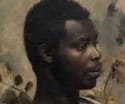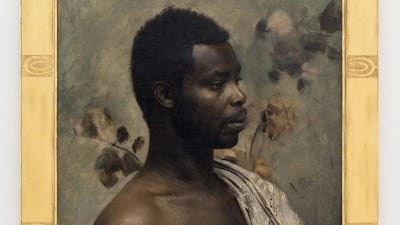A Long-Lost Klimt Painting of an African Prince Goes on Show.

An early painting by renowned. Austrian artist Gustav Klimt, believed lost since the 1930s, has recently resurfaced and is now on public display. The portrait features Prince William Nii Nortey Dowuona, a representative of the Ga people, an ethnic group from present-day Ghana known for their deep-rooted cultural traditions, rich history, and elaborate festivals. This discovery not only marks a significant moment in the art world but also highlights an important historical figure whose legacy is deeply tied to his people.
A Rediscovered Masterpiece
The artwork, painted in 1897, measures just over two feet tall and depicts Prince Dowuona in profile, set against a backdrop of loose floral brushstrokes. It was recently exhibited by the Viennese gallery Wienerroither & Kohlbacher (W&K) at the TEFAF art fair in Maastricht, Netherlands, with an asking price of €15 million (approximately $16.3 million).

Who Were the Ga People, and Who Was Prince William Nii Nortey Dowuona?
The Ga people, an influential ethnic group in Ghana, are known for their resilience, urban settlements, and strong leadership structures. They played a significant role in West African trade, governance, and resistance against colonial powers. The Ga rulers, including Prince Dowuona, were key figures in shaping the identity and governance of their people during a time of increasing European intervention in Africa.
Prince Dowuona’s presence in Klimt’s work suggests he may have had a role in diplomatic or cultural exchanges with Europe. As a Ga royal, he would have been involved in leadership decisions, negotiations with European traders, and preserving the cultural heritage of his people. His representation in Austrian art provides a rare glimpse into African-European relations in the late 19th century.
The Painting’s Mysterious Journey
The journey of this artwork is as captivating as the piece itself. After being auctioned from Klimt’s estate in 1923, the painting was later loaned to an exhibition in 1928 by Ernestine Klein, who, along with her husband Felix Klein, had converted the artist’s studio into a villa.
However, in 1938, the Jewish couple was forced to flee Vienna for Monaco as Nazi persecution intensified, leaving behind the painting, which soon disappeared without a trace. For decades, its whereabouts remained unknown—until 2023, when two collectors approached W&K gallery with a "heavily soiled" canvas bearing a barely visible Klimt estate stamp.
Through extensive research, art historian Alfred Weidinger, who had been searching for the painting for two decades, authenticated the work. Following meticulous restoration and a restitution settlement with Klein’s heirs, the painting was brought back into public view.
Why This Discovery Matters
This rediscovery adds an essential piece to Klimt’s early works while also shining a light on African figures who were historically connected to European art and culture. The portrait of Prince Dowuona serves as a powerful symbol of the Ga people's historical influence, emphasizing the global interconnectedness of African leaders and European artists at the turn of the 20th century.
The unveiling of this painting at TEFAF presents an opportunity to reflect on forgotten histories and recognize Africa’s presence in classical European art.
For a more detailed account, please refer to Jacqui Palumbo’s article on CNN.
Read More on CNN
The Equatorial Gulf is an independent group of writers dedicated to insightful analysis and thought-provoking discussions on global and regional topics.
Comments ()